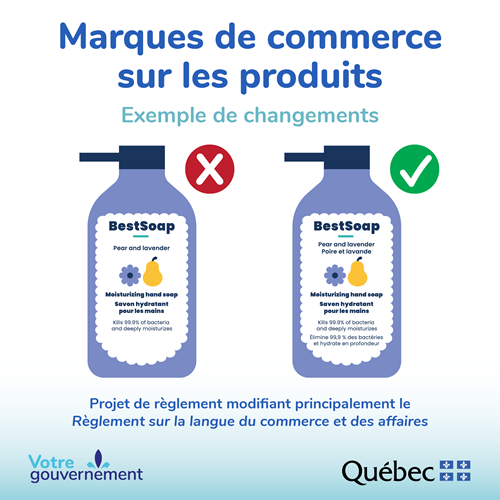Le 10 janvier 2024, le gouvernement du Québec a publié son très attendu projet de Règlement modifiant principalement le Règlement sur la langue du commerce et des affaires (le projet de règlement).
S’il est adopté dans sa mouture actuelle, le projet de règlement porterait application du projet de loi 96 (adopté le 1er juin 2022), lui-même source d’importantes modifications à la Charte de la langue française (la Charte). Les exigences du projet de loi 96 ont déjà eu une forte incidence sur les entreprises qui mènent des activités au Québec. Elles touchent en particulier la publicité sous toutes ses formes, y compris l’affichage public, la publicité numérique et les emballages et étiquettes de produits. Le projet de règlement a pour objet d’appuyer le projet de loi 96 et d’en clarifier certains termes. Il vise également à modifier le Règlement sur la langue du commerce et des affaires et à révoquer le Règlement précisant la portée de l’expression « de façon nettement prédominante » pour l’application de la Charte de la langue française. Les principales modifications proposées à propos des inscriptions sur les produits sont examinées ci-dessous. Pour en savoir plus sur celles qui concernent l’affichage public, lisez ce billet.
Inscriptions sur les produits
Régime actuel (en vigueur jusqu’au 1er juin 2025)
En principe, sous le régime actuel, toute inscription (notamment dans un logo ou une marque de commerce) figurant sur un produit, ou encore sur son contenant, son emballage ou tout document ou objet qui l’accompagne, doit être en français. Une traduction doit être ajoutée, mais celle-ci ne peut l’emporter sur le texte rédigé en français.
Cette règle générale a plusieurs exceptions, dont celle de la « marque de commerce reconnue », qui permet l’affichage, sans traduction française, d’une marque de commerce dans une langue autre que le français (p. ex. en anglais) – qu’elle soit déposée ou non – sur un produit ou son emballage. Cette exception s’applique si le texte en question est une marque de commerce reconnue pour laquelle aucune version française n’est déposée.
Modifications proposées par le projet de loi 96 (en vigueur à compter du 1er juin 2025)
Sous le régime du projet de loi 96, l’exception de la « marque de commerce reconnue », qui permet l’affichage de marques de commerce dans une langue autre que le français, ne s’applique qu’aux marques de commerce déposées.
En outre, tout générique ou descriptif doit également figurer en français sur le produit ou son emballage, même s’il fait partie d’une marque de commerce déposée.
Ces deux nouvelles exigences doivent entrer en vigueur le 1er juin 2025.
Projet de règlement (publié le 10 janvier 2024)
Le projet de règlement publié par le gouvernement du Québec prévoit les modifications suivantes :
- Les « marques de commerce déposées » comprennent les marques de commerce en cours d’enregistrement Le projet de règlement élargit le sens du terme « marque de commerce déposée » pour qu’il englobe les marques de commerce dont la demande de dépôt est en traitement (c.-à-d. les marques en cours d’enregistrement). Cette modification concerne l’exception de la « marque de commerce déposée », laquelle vise les marques de commerce affichées sur les produits, contenants et emballages, mais pas celles qui figurent sur l’affichage public ou dans la publicité commerciale, qui sont assujetties à d’autres règles.
Si cette modification est adoptée, les titulaires d’enregistrements et les personnes dont la demande est en instance pourront se prévaloir de l’exception de la « marque de commerce déposée » décrite ci-dessus pour les marques de commerce qui figurent sur leurs produits et emballages. Voilà qui pourrait servir à ceux qui ont besoin de plus de temps en amont pour rendre leurs emballages conformes aux nouvelles règles. Ce changement pourrait aussi aider à compenser les délais administratifs prolongés auxquels font face les demandeurs qui souhaitent faire enregistrer leurs marques de commerce au Canada auprès de l’OPIC.
- Portée des termes « générique » et « descriptif » aux fins des exigences de traduction : Le projet de loi 96 impose la traduction des génériques et descriptifs qui figurent sur les produits et emballages, même lorsqu’ils font partie d’une marque de commerce déposée. Le projet de règlement cherche à expliquer cet aspect du projet de loi 96 en indiquant qu’un générique « réfère à un ou plusieurs mots décrivant la nature d’un produit », et qu’un descriptif « réfère à un ou plusieurs mots décrivant les caractéristiques d’un produit ».
Toutefois, on ne sait pas encore comment l’Office québécois de la langue français (OQLF), l’organe directeur chargé d’appliquer la Charte et ses règlements, interprétera et appliquera ces règles en pratique.
- Les règles relatives aux génériques et aux descriptifs visés par l’exigence de traduction seront appliquées aux emballages, aux documents et aux autres objets : Le projet de règlement précise que les règles régissant la traduction en français de génériques et de descriptifs sur un « produit » s’appliquent également au contenant ou à l’emballage d’un produit, de même qu’aux documents et objets qui l’accompagnent. Par exemple, les cartes de garantie, les manuels d’utilisation et les reliefs (qui comprennent du texte) doivent aussi être conformes.
- Exigences d’apparence pour les traductions en français de génériques et de descriptifs : Lorsqu’un générique ou un descriptif figure sur un produit ou son emballage dans une langue autre que le français (qu’il fasse ou non partie d’une marque de commerce déposée), il doit aussi s’y trouver en français, de sorte que la version dans l’autre langue ne l’emporte pas sur la version en français et qu’elle ne soit pas accessible dans des conditions plus favorables que celle-ci.
Suivant cet article du projet de règlement, tous les descriptifs et génériques (y compris ceux qui font partie d’une marque de commerce déposée) qui doivent être traduits en français ne doivent pas occuper plus d’espace que la traduction en français. Le gouvernement du Québec a donné l’exemple suivant pour illustrer comment un commerçant pourrait se conformer à cette disposition du projet de règlement :

Source: Gouvernement du Québec
On constate qu’aux fins de conformité au projet de règlement, une traduction française des fragrances (« poire et lavande ») et des propriétés du produit qui sont jugées descriptives (« Élimine 99,9 % des bactéries et hydrate en profondeur ») a été ajoutée à l’emballage du produit, dans les mêmes police et taille de caractères que son pendant anglais.
- Période d’élimination progressive des produits non conformes : Le projet de règlement prévoit une période d’élimination progressive de deux ans, soit jusqu’au 1er juin 2027, pour la vente des produits non conformes aux nouvelles exigences linguistiques (c.-à-d. celles du projet de loi 96 et du Règlement), pourvu que ceux-ci aient été fabriqués avant le 1er juin 2025 et qu’aucune version française de la marque de commerce apparaissant sur le produit en question n’ait été déposée à la date où le Règlement est publié dans sa version définitive. Cette modification permettrait l’écoulement de tout inventaire de biens jugés non conformes malgré l’entrée en vigueur des modifications au projet de loi 96 et au Règlement.
Documents commerciaux
Régime actuel (en vigueur jusqu’au 1er juin 2025)
Sous le régime de la Charte, les catalogues, les brochures, les dépliants, les annuaires commerciaux, les formulaires de commande et tous les autres documents de même nature rendus disponibles au public doivent être rédigés en français. Ces documents peuvent aussi être fournis dans une autre langue si la version française est disponible dans des conditions au moins aussi favorables que cette traduction.
Modifications proposées par le projet de loi 96 (en vigueur à compter du 1er juin 2025)
Le projet de règlement précise que l’exigence relative aux « documents commerciaux » du régime en vigueur s’appliquera également aux sites Web et aux pages de médias sociaux. Cela concorde avec une position adoptée antérieurement par l’OQLF.
Comment se préparer à l’entrée en vigueur éventuelle du Règlement
Le projet de règlement est soumis à une période de consultation de 45 jours (lancée le 10 janvier 2024), et nous n’en connaissons donc toujours pas la version définitive, mais il y a lieu pour les entreprises qui mènent des activités au Québec de prendre certaines mesures en amont pour s’assurer que leurs emballages de produits et documents publicitaires destinés aux consommateurs québécois sont conformes aux exigences du projet de loi 96 et du projet de règlement.
- Veiller à ce que les marques de commerce soient déposées ou en cours d’enregistrement : Demandez-vous si vos marques de commerce affichées dans une langue autre que le français sur vos produits ou leurs emballages sont déposées ou sont, ou devraient faire, l’objet d’une demande d’enregistrement. Demandez-vous s’il y a lieu de demander l’enregistrement de marques de commerce « de common law » auprès de l’Office de la propriété intellectuelle du Canada.
- Repérer les génériques et les descriptifs dans vos marques de commerce : Songez à passer en revue vos marques de commerce déposées et en cours d’enregistrement pour en recenser les génériques et descriptifs, car ceux-ci devront être traduits en français même s’ils font partie d’une marque de commerce déposée. Il se peut bien que, pour vous conformer au projet de règlement, vous deviez consulter votre service de marketing, qui devra prévoir les espaces nécessaires sur vos étiquettes pour que les génériques et descriptifs traduits en français prennent autant de place que leurs versions anglaises.
- Reformuler vos marques de commerce : Pour qu’un produit soit visé par la période d’élimination progressive de deux ans permettant la vente des produits non conformes, laquelle prendra fin le 1er juin 2027, il ne doit pas s’y trouver de marque de commerce dont une version française est déposée en date de la publication de la version finale du Règlement. Il incombe donc aux décideurs d’évaluer minutieusement l’opportunité de demander l’enregistrement d’une version française de leurs marques de commerce.
Comme l’OQLF juge qu’une marque bilingue (c.-à-d. contenant des termes en anglais et en français) est « en français », il y a lieu pour les entreprises dont des demandes d’enregistrement de marques bilingues sont en traitement de se demander s’il ne vaudrait pas mieux abandonner celles-ci en faveur de versions unilingues.
Si vous avez des questions sur le projet de règlement, les exigences du projet de loi 96, la Charte de la langue française ou leur application au Québec, nous vous invitons à communiquer avec les auteurs de ce bulletin et vos personnes-ressources au sein des équipes de Propriété intellectuelle et des Affaires réglementaires.







